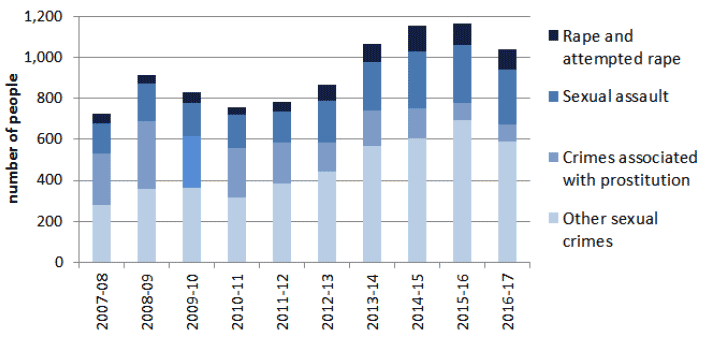Criminal proceedings in Scotland 2016-17: statistics
Statistics on criminal proceedings concluded in Scottish courts and alternatives to prosecution, issued by the police and by the Crown Office.
This document is part of a collection
6. People convicted by crime group
Non-sexual crimes of violence
Non-sexual crimes of violence include the crimes of homicide, attempted murder & serious assault, robbery and other violent crime (see Annex D for a full listing). Convictions for these types of crimes fell by three per cent in 2016-17 to 1,722, from 1,776 in 2015-16. This is 37% lower than the level of convictions in 2007-08 (2,750 convictions), and all crimes within this group are at their lowest level in the last ten years.
The smallest decline for an individual crime type within non-sexual crimes of violence was for attempted murder and serious assault, down one per cent from 1,118 convictions in 2015-16 to 1,110. The number of convictions for robbery also decreased by a relatively small three per cent from 384 convictions in 2015-16 to 372 in 2016-17. The number of convictions for homicide has fallen another eight per cent to 77 in 2016-17, and is now 43% below its 2007-08 level (136 convictions).
Convictions for other non-sexual crimes of violence declined by 14% from 190 convictions in 2015-16 to 163 in 2016-17.
Sexual crimes
The number of convictions for sexual crimes fell by 11% in 2016-17 to 1,037 convictions. This follows five consecutive annual rises, although convictions in 2016-17 remain 37% higher than in 2010-11 (756 convictions). The rise since 2010-11, in part, likely reflects an increased level of reporting in the wake of high profile cases and a corresponding rise in the number of people being proceeded against in court, up 62% since 2010-11 from 933 proceedings to 1,510 in 2016-17, although this number was at a high in 2014-15 at 1,644.
The number of convictions for rape and attempted rape decreased by seven per cent (from 105 in 2015-16 to 98 in 2016-17). The number of proceedings for these crimes increased this year to 251 from 216 in 2015-16, up 16%. However, the number of convictions for rape and attempted rape have nearly tripled since 2010-11 (36 convictions). Please note that recording delays are typical for high court activity due to the complex nature of cases held there. As a result the number of convictions for rape and attempted rape for 2016-17 may be slightly underestimated.
The number of sexual assault convictions has fallen by four per cent in 2016-17, to 266 convictions. This follows four consecutive rises in convictions since 2011-12 (151 convictions) with numbers now 76% higher.
Chart 5: Sexual crime type convictions, 2007-08 to 2016-17

Over the last decade, chart 5 shows that it is other sexual crimes [2] that have grown as a proportion of all sexual crimes to make up the majority. "Other sexual crimes" made up 42% of all sexual offence convictions in 2010-11 (315 convictions) but their share rose to 60% by 2015-16 (694 convictions), before falling back to 57% in 2016-17 (590 convictions). The growth in the proportion of this crime type has been partly driven by increases in convictions for "taking, distribution, possession etc of indecent photos of children", and for "communicating indecently".
The other categories of sexual crimes have declined only slightly from 2015-16, and convictions for crimes associated with prostitution remained at its notably low level with 83 convictions, 67% lower than in 2007-08. Given the small numbers for these types of proceedings there are year on year fluctuations for levels of convictions for these types of crimes. In 2016-17, the conviction rate for rape and attempted rape fell by 10 percentage points to 39%, its lowest rate since 2008-09. This was caused by a combination of a 16% increase in the number of proceedings (from 216 in 2015-16 to 251 in 2016-17), and a seven per cent decrease in convictions from 105 to 98.
Crimes of dishonesty
As a proportion of all crimes, convictions for crimes of dishonesty (which is mainly shoplifting and theft) accounted for nearly a third (33%) of all convictions in 2016-17 (10,795 convictions). As shown in chart 6, convictions for these types of crimes have steadily declined in the last ten years down from 17,728 in 2007-08 to 10,795 convictions in 2016-17 (a drop of 39%).
The total number of proceedings has declined at a similar rate, down 38% from 19,901 in 2007-08 to 12,296 in 2016-17. This is reflective of fairly stable conviction rates for crimes of dishonesty, which have varied between 86 and 89% over the last ten years.
Chart 6: Convictions for Crimes of Dishonesty 2007-08 to 2016-17

Overall convictions for crimes of dishonesty declined by seven per cent in 2016-17, down to 10,795 convictions from 11,605 in 2015-16. There were declines in all crime types within crimes of dishonesty between 2015-16 and 2016-17, with the exception of small rises in housebreaking and fraud:
- Housebreaking convictions increased by one per cent from 858 to 868 convictions;
- Fraud convictions up by one per cent from 545 to 548, although this is 59% lower than in 2007-08 (1,337 convictions); and
- Theft from motor vehicle convictions fell by eight per cent from 101 to 93 convictions.
Contact
There is a problem
Thanks for your feedback